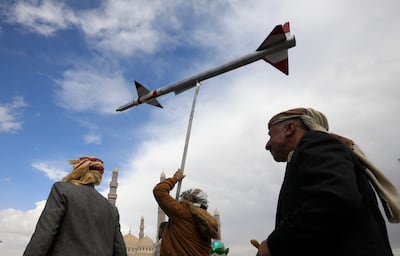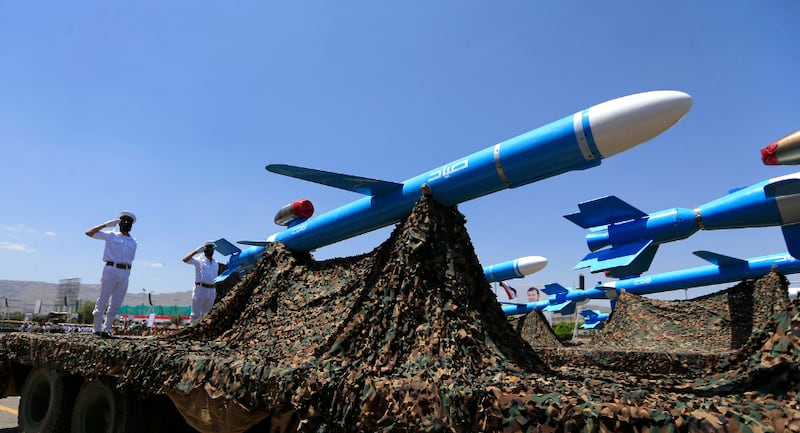Live updates: Follow the latest on Israel-Gaza
Israel on Tuesday night confirmed a Houthi cruise missile had landed near the city of Eilat in the country’s south, the first time the group has successfully breached Israeli air defences.
“A cruise missile coming from the direction of the Red Sea fell in an open area, the target was being monitored by Air Force forces,” said a statement from the Israeli military. “There were no casualties and no damage was caused. The incident is being investigated.”
Although there were no deaths or injuries, it represents a demonstration of long-range attack capability for the Iran-backed militia.
The missile was launched from Houthi-controlled Yemen, about 1,600km from the target.
The longest-range US cruise missile, the AGM-158B-2, has a range of about 1,900km.
Houthi cruise missiles used before the current Gaza war were thought to have a range of about 1,300km, based on their use on targets in Saudi Arabia during Yemen's civil war.
The group's longest-range missile, the Quds-3, has a claimed range of 2,000km and is the only type capable of flying to Eilat.
The Houthis have another long-range missile, the Toufan, but unlike a low-flying cruise weapon that sneaks under radar beams, it flies at high altitude and is more vulnerable to air defences.

Houthi arsenal
The Houthis have also fired volleys of ballistic missiles, cruise missiles and drones at Israel since the Gaza war began on October 7, but none of the projectiles hit their targets.
On October 23, a Houthi drone exploded in the Egyptian town of Taba, injuring six, while in November a drone struck Eilat from the direction of Syria, from where it was fired by Iran-backed militias.
Previous ballistic and cruise missile attacks by the Houthis against Israel have been intercepted by US and Israeli warships, jet aircraft and land-based air defences.
Cruise missiles such as the one that struck Eilat on Tuesday can be tracked and shot down by jets – a tactic the Israelis have used – but that depends on keeping aircraft present in the air for long periods, a costly operation.
Cruise missiles fly low to the ground – rarely higher than 150 metres – making them hard for radar beams to detect at long range, due to hills and the Earth's curvature. They can also navigate and change direction at low level, complicating the task of air defence forces.
The Houthis fired Quds-3 cruise missiles towards Israel last year but they were shot down by the USS Carney warship over the Red Sea.
Ballistic missiles, by contrast, fly at high altitude, generally on a predictable “ballistic arc”, giving air defences such as the US Patriot or the Israeli Arrow ample time to spot and intercept them.

Increased accuracy?
The relatively successful deployment of the cruise missile, which succeeded in getting past Red Sea naval air defences despite not hitting a target, could be a milestone in Iranian power projection.
“Iran is likely taking the opportunity to test weapons systems in an actual theatre of war. They do this by providing their advanced weapons systems to their proxy forces,” Mick Mulroy, former US Deputy Assistant Secretary of Defence for the Middle East, told The National.
The Houthis say their intervention in the Gaza conflict, by blockading the Red Sea, is intended to pressure Israel into a ceasefire. Mr Mulroy, a former CIA officer, said Iran “directly contributed to the conflict in Gaza” by supplying Hamas with most of its military capacity.
In 2019, Houthis used Iranian-designed cruise missiles – according to a UN investigation – to hit oil infrastructure in Khurais, Saudi Arabia, about 800km from Houthi-controlled territory.
The Quds-1 missile was used, which experts say is a slightly modified version of the Soumar cruise missile, an Iranian weapon, part of a pipeline of Iranian arms established for the Houthis as far back as 2009, the UN found.
The Quds-3 is an evolution of the Quds-1, extended for more fuel capacity, according to the International Institute for Strategic Studies.
While the weapons prove challenging to shoot down, the US has invested heavily in upgrading Patriot air defence missile systems to hit low-flying cruise missiles, systems that have been supplied to Israel by the US and Germany.
While the Israelis did not confirm what was used to track the missile, it also has the David's Sling missile defence system, which like the Patriot is capable of choosing not to intercept missiles that are heading for open ground – as may have been the case in Eilat.







